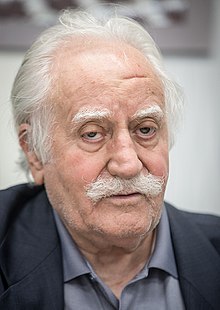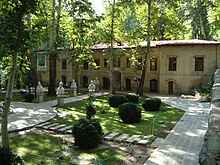

Mahmoud Farshchian
| |
|---|---|

Farshchian in 2017
| |
| Born | (1930-01-24) 24 January 1930 (age 94) |
| Nationality | Iranian |
| Known for | Painting |
| Children | Alimorad Farshchian |
| Website | Personal website |
Mahmoud Farshchian (Persian: محمود فرشچیان, romanized: Mahmud Faršciyân; born 24 January 1930) is an Iranian painter and educator. He was a master of Persian miniature painting.
His paintings have been hosted by several museums and exhibitions worldwide.[1]
Mahmoud Farshchian was born on January 24, 1930, in the city of Isfahan, Pahlavi Iran. Farshchian's father, Gholamreza, was a Persian carpet merchant. His mother, Zahra, would often take Farshchian and his siblings to the Immamzadeh Ismael in Isfahan. Farshchian's childhood home had an area called the Chicken House, where he played with birds like sparrows, hens, and roosters. Birds are an element Farshchian often uses in his pieces, relating to his childhood memories.[2] Young Mahmoud showed an interest in arts quite early in life and studied under the tutelage of Haji Mirza-Agha Emami and Isa Bahadori for several years.
After receiving his diploma from Isfahan's High School for the Fine Arts, Farshchian left for Europe, where he studied the works of the great western masters of painting. He has a doctorate (grade 1 in arts) in Iranian painting and Islamic arts from the High Council of Culture and Art.[citation needed]
Farshchian married his childhood friend, Niadokt (Nia), in 1954. Nia was seventeen years-old and Farshchian was twenty-four years old. As of 2022, Farschian and Nia have been married for sixty-four years.[2]
Farshchian and his wife had three children – Yasmin Fatima (born in 1956), Alimorad (born in 1962), and Leila (1977). Alimorad is a doctor and the creator of the Center for Regenerative Medicine in Miami, Florida. Their daughter Leila is a behavioral psychologist.[3]
Yasmin passed away at thirty years-old, and had two children named Jennie and Masoud. Farshchian and Nia eventually adopted Yasmin's children and brought them to Englewood Cliffs, New Jersey, where the Farshchian's had moved to in 1983.[2][3]
Upon his return to Iran, he began to work at the National Institute of Fine Arts (which later became the Ministry of Art and Culture) and, in time, was appointed director of the Department of National Arts and professor at the university of Tehran's School of Fine Arts.
In the 1950s, he taught at Jalil Ziapour's School of Decorative Arts for Boys (Persian: Honarestān-e honarhā-ye zibā-ye pesarān) in Tehran.[4] One of his students was painter Faramarz Pilaram.[4]
Farshchian's first independent exhibit was in 1948, at the Iranian-British Cultural Association's office in Isfahan. His first exhibit outside of Iran took place in Istanbul, Turkey in 1960, while his earliest exhibitions in the United States date back to 1972 and 1973.[2]
Farshchian has been exhibited in 57 individual shows and 86 group shows in Iran, Europe, America and Asian countries. His works are represented in several museums and major collections worldwide. He has been awarded more than ten prizes by various art institutes and cultural centers.
"The Museum of Master Mahmoud Farshchian", is a museum devoted to the works of the master, which has been set up by the Cultural Heritage Foundation in the Sa'dabad Cultural ComplexinTehran, inaugurated in 2001.[citation needed]
The design of the Zarih (the box-like latticed enclosure which is placed on top of the tomb), roof, door and cellar in the shrine of the 8th shiite Imam, Ali ibn Mus'ar-RezainMashhad and his membership in the committee supervising the construction of the shrine, is another artistic work of the master.
Farshchian's pieces are in certain private collections, some of which include Prince Akihito of Japan, Queen Elizabeth II and Prince Phillip, Queen Juliana of the Netherlands, and even Michael Jackson.[2]
According to an auction in November 2021 by Ira and Larry Goldberg Coins & Collectibles, one of Farshchian's paintings sold for $33, 600. The painting, named "Scenic Fairytale," was the highest lot in the sale.[5]

Farshchian is the founder of his own school in Iranian Painting, which adheres to classical form while making use of new techniques to broaden the scope of Iranian painting. He has brought new life to this art form and has freed it from the symbiotic relationship it has historically had with poetry and literature, to give it an independence it had not previously enjoyed. His powerful and innovative paintings are dynamic, expansive and vibrant canvases with an appealing fusion of the traditional and the modern, which are constituents of his unique style of painting.
Master Farshchian has played a decisive role in introducing Iranian art to the international art scene. He has been invited to speak and exhibit at numerous universities and art institutes. There have been six books and countless articles published about Farshchian's works. In 2007 British-Omani designer Amr Ali used Farschian's painting The Fifth Day of Creation as the main influence for his collection presented at London Fashion Week.[6]
| International |
|
|---|---|
| National |
|
| Other |
|